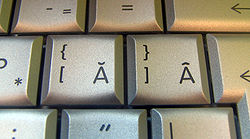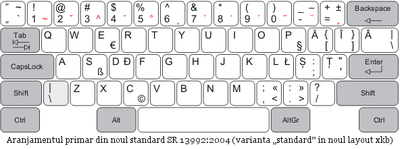Romanian keyboard layout
This article needs more links to other articles to help integrate it into the encyclopedia. (September 2017) |


The current Romanian National Standard SR 13392:2004 establishes two layouts for Romanian keyboards: a "primary" one and a "secondary" one.
The “primary” layout is intended for more traditional users that learned long ago how to type with older, Microsoft-style implementations of the Romanian keyboard. The “secondary” layout is mainly used by programmers and it does not contradict the physical arrangement of keys on a US-style keyboard. The “secondary” arrangement is used as the default one by the majority of GNU/Linux distributions.
There are four Romanian-specific characters that are incorrectly implemented in all Microsoft Windows versions before Vista:
- U+0218 Ș LATIN CAPITAL LETTER S WITH COMMA BELOW – incorrectly implemented as U+015E Ş LATIN CAPITAL LETTER S WITH CEDILLA
- U+0219 ș LATIN SMALL LETTER S WITH COMMA BELOW – incorrectly implemented as U+015F ş LATIN SMALL LETTER S WITH CEDILLA
- U+021A Ț LATIN CAPITAL LETTER T WITH COMMA BELOW – incorrectly implemented as U+0162 Ţ LATIN CAPITAL LETTER T WITH CEDILLA
- U+021B ț LATIN SMALL LETTER T WITH COMMA BELOW – incorrectly implemented as U+0163 ţ LATIN SMALL LETTER T WITH CEDILLA
Since Romanian hardware keyboards are not widely available, Cristian Secară has created a driver that allows the Romanian characters to be generated with a US-style keyboard, in all Windows versions previous to Vista. It uses the right AltGr key modifier to generate the characters.[1]
An alternative, more ergonomic (though non-standard) keyboard layout, with a user choice between cedillas and commas, is proposed and implemented for the Microsoft Windows operating system by the Ergo Romanian project. They suggest altering keys on the standard QWERTY layout which are less frequent in Romanian, namely q, w, y, k, x, to produce Romanian characters ă, ș, ț, î, â, respectively.[2]
QWERTZ keyboard (former)

Before Windows Vista, this keyboard was used. The comma from S and T is replaced by the cedilla (in some fonts the T-cedilla character is rendered as T-comma, as in some Adobe fonts). In 2012, a new keyboard was introduced. This keyboard was built after the same QWERTZ model, but instead of S-cedilla and T-cedilla are S-comma and T-comma.[3]
References
- ^ Cristian Secară. "RO Keyboard" (in Romanian). Retrieved 19 January 2013.
- ^ Anasoftware. "Ergo Romanian". Archived from the original on 25 March 2009. Retrieved 6 January 2009.
- ^ Cristian Adam. "The Română (Moștenit) keyboard" (in Romanian). Retrieved 27 November 2012.
